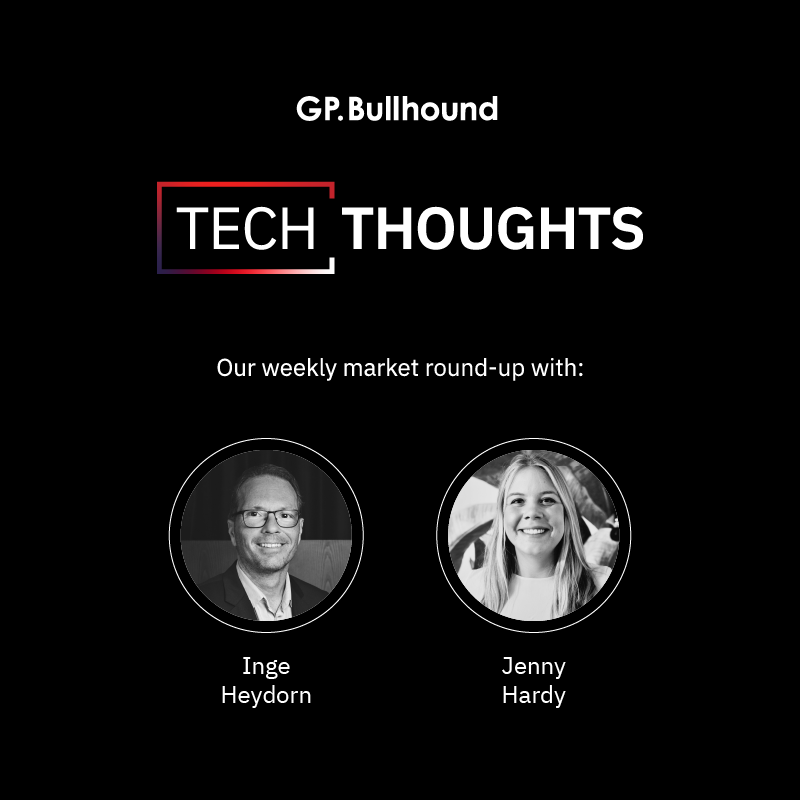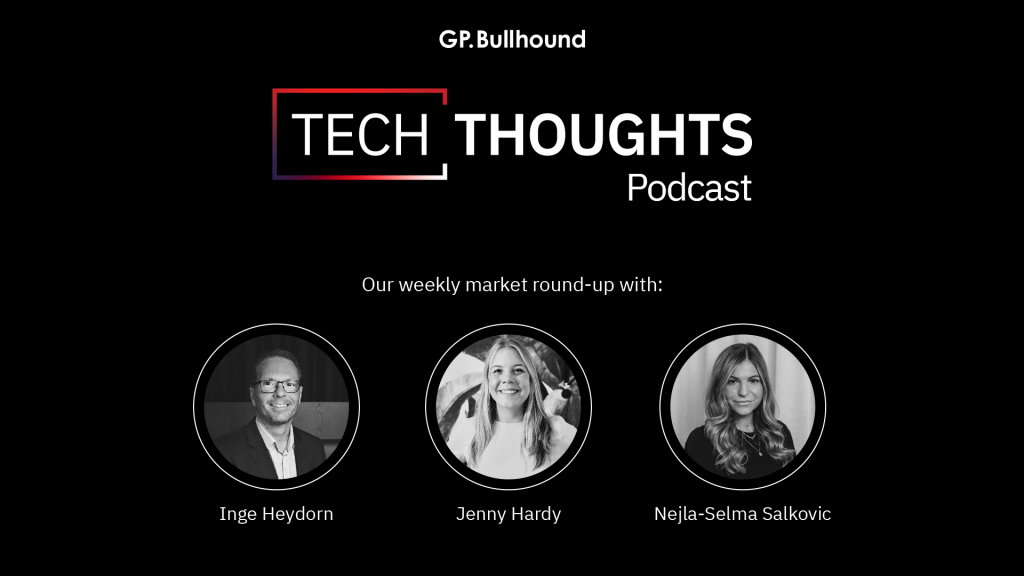Tech Thoughts Newsletter – 16 June 2023.

Market: The stock market continued to move up during the week with a continued broadening of market leadership beyond AI and tech.
Portfolio: By way of a fund performance update: GTF is up 40% YTD, and Thyra hedge is up 12.5% YTD.
We’re now starting to get most of the way through Q2 results season and moving more to investor days, which this year seem to have mostly been rebranded “AI days”..!
AMD sets out to compete directly with Nvidia in GPU
- AMD held its “Data Center and AI” event on Tuesday, with the main news being an announcement of the MI300X, a pure GPU, which we would see as targeting directly Nvidia’s H100 product.
- It’s important because it shows the extent to which they view having a pure GPU solution (vs their prior combined CPU+GPU) as important – and in turn the extent to which they’re currently seeing the AI market get locked up by Nvidia.
- The GPU’s standout features are around its 8 channels of HBM3 (total 192GB vs. only 80GB in Nvidia’s H100..). Memory is important and it has been a bottleneck in terms of performance for the current generation of LLMs for AI. It might allow some LLMs to run on a single chip.
- The MI300X will be built on TSMC’s 5nm node and will supposedly sample in Q3, with not seeing meaningful volume until 2024. Regardless of capacity at TSMC, ramps at this architecture take time, so we still assume Nvidia H100 dominates the market this year.
- They also expanded their AI TAM to $150bn by 2027 (from $30bn today, so >50% CAGR). We take TAM’s a bit with a pinch of salt: in AI we still don’t know how big the training market will be, including how many unique LLMs will exist. And indeed it’s very likely that some CPU infrastructure will be bought to run both neural networks and more traditional workloads. There is no doubt though that we are very early in the innings of an AI infrastructure build out, and AMD will benefit.
Portfolio view: we own Nvidia and AMD as our key AI GPU/CPU exposures in the portfolio (and TSMC, who make both chips). There is still lots for AMD to do to catch up with Nvidia from a total AI system performance perspective. But what we do know is that there are also lots of reasons why AI players will not want to be tied into Nvidia to the extent that they are currently – everyone is motivated to look for a credible alternative to Nvidia so as not to be tied into one very powerful supplier. And clearly AMD is the most credible alternative here. We still expect the training market to be dominated by Nvidia, but see inference as a much broader competitor set, with solutions depending much more on the nature of workloads vs a simple brute performance (which Nvidia is no doubt leading in thanks also to its strong networking and interconnect capability). We expect them both to be key winners.
Salesforce had its AI day in New York on Monday…
- The “AI cloud starter pack” was announced at $360k per year (though partly usage based) which is amongst the first explicit monetisation plans we’ve heard from software businesses. (It is rumoured Microsoft is trialling its AI features with a number of customers at a flat fee of $100k per 1000 seats)
- Salesforce has made several AI product suite announcements in recent months, including announcements of Commerce GPT and Marketing GPT last week.
- It will allow its users to do things like auto generate code for developers, generate marketing landing pages for marketers and write customised sales emails.
- We’ve spoken before that AI as an enterprise opportunity makes sense. Established enterprise software businesses who are able to (1) leverage very large installed bases to upsell AI features; (2) have large cash balances to invest in AI; (3) have the right business model for AI to match the increased cost – ie. subscription, not pay per click (like search).
- And for enterprise software customers it makes much more sense to get AI capabilities via their existing platform software providers than to try to implement it themselves.
- Given Salesforce’s broad product set they are well set up to utilise AI. In just the same way as Microsoft operating AI across its suite of apps is compelling, Salesforce should be able to do the same – the AI starter pack includes features around Slack, Tableau, Einstein, Mulesoft and Data Cloud.
…AI as ARPU upside for Adobe too
- Adobe (owned) reported solid enough results – beating top line and EPS (op margin beating by ~1ppt) and raising EPS guidance. The key Digital Media net new ARR figure was particularly good, and returned to yr/yr growth.
- Like all software businesses right now, the hot debate is the extent to which generative AI cannibalises seat TAM for Adobe or adds incremental ARPU/content generation opportunities.
- But like Salesforce, they have a tangible plan for monetisation of AI which is positive: “Our generative AI offerings represent additional customer value as well as multiple new monetization opportunities. First, Firefly will be available both as a standalone freemium offering for consumers as well as an enterprise offering, announced last week. Second, co-pilot generative AI functionality within our flagship applications will drive higher ARPUs and retention. Third, subscription credit-packs will be made available for customers who need to generate greater amounts of content. Fourth, we will offer developer communities access to Firefly APIs and allow enterprises the ability to create exclusive custom models with their proprietary content. And finally, the industry partnerships, as well as Firefly, represent exciting new top-of-funnel acquisition opportunities for Express, Creative Cloud and Document Cloud. Our priority for now is to get Firefly broadly adopted, and we will introduce specific pricing later this year.”.
Portfolio view: The question for us in software and AI has been when and if AI starts to be a meaningful revenue generator for software companies, rather than the current cost of doing business. Salesforce and Adobe’s monetisation plan is helpful in that it starts to answer that question. We ultimately think AI will lead to more consolidation of spend in the space, and those “platform like” software businesses (We own Microsoft, ServiceNow, Salesforce, Workday and Adobe) are the best positioned both from a scale of investment and from a product set perspective (with an ability to leverage AI tools across a broad product suite). We would note that nothing’s for free – all of these businesses will likely need to either up capex to build out their own infrastructure, or buy AI compute capacity from cloud providers, which we’ll likely see impact their gross margin. In the context of their existing businesses, AI is still small, so we’re not seeing that yet, but it’s something to watch, and key for us in the portfolio is those businesses that can generate a meaningful and sustainable return on invested capital from those AI investments.
AI arms race continues
- Oracle (not owned) – reported. Their cloud revenue (they are the 4th public cloud provider behind AWS, Azure and Google) accelerated 20ppts to +77% yr/yr with the outlook showing continued cloud strength (Oracle is in catch up mode and gaining albeit from much lower share levels). Oracle is one of the few vendors with compute scale and GPU capacity and so is seen as a beneficiary of AI.
- Lenovo (not owned) stated that it now has reached an annual AI infrastructure revenue of over $2bn. The company will also invest an additional $1B over three years to boost artificial intelligence (AI) deployment for businesses globally.
- Accenture (not owned) announced they’re investing $3bn over the next 3 years in AI: “There is unprecedented interest in all areas of AI, and the substantial investment we are making in our Data & AI practice will help our clients move from interest to action to value, and in a responsible way with clear business cases,” said Julie Sweet, chair and CEO, Accenture. “Companies that build a strong foundation of AI by adopting and scaling it now, where the technology is mature and delivers clear value, will be better positioned to reinvent, compete and achieve new levels of performance. Our clients have complex environments, and at a time when the technology is changing rapidly, our deep understanding of ecosystem solutions allows us to help them navigate quickly and cost effectively to make smart decisions.”
Portfolio view: everyone (cloud providers like Oracle, Server players like Lenovo, and consultants like Accenture) needs to invest in AI to keep up with competitors doing the same. We don’t own Oracle but importantly for us, their 12 month trailing capex spend almost doubled yr/yr and is expected to stay at similarly high levels. Similarly, we think Lenovo’s flagship AI inference server “ThinkEdge SE360 V2” will be upgraded soon to the latest Nvidia chips (as soon as they can get supply…).
It’s important for our thesis on Nvidia, AMD and TSMC – cloud players need to spend on GPU compute capacity and AI features to maintain share – that ultimately means more high-end servers and more chips.

Taiwanese monthly sales showing some stabilisation
- MediaTek (not owned), reported last Friday that their May sales were up 11.3% mth/mth but still down a lot yr/yr. The mth/mth figure indicates that even if demand in the handset market and especially in China has not improved it is stabilising.
- On the PC side we did see some stabilisation in the May numbers on aggregate but still very volatile on an individual company with stronger numbers from Inventec, Acer while Asustek and Compal missed.
- We believe that we are close to the bottom in terms of shipments for PC and Smartphone as much of the excess inventories has been worked off but underlying demand is still weak.
Portfolio view – we don’t own any of these companies given their consumer exposure. While we’re seeing signs of light at the end of the tunnel in the consumer semis inventory correction (likely Q2), the reality is that consumer exposed semis will still struggle to perform if consumer end demand remains weak (and where China remains a big factor). Consumer is an area particularly sensitive to supplier discipline, because so much consumer semi content is commoditised or fungible.
Semicap and geopolitics driving spend
- Memory chip maker Micron has according to news reports this morning announced ~$600m investment into its Xi’an packaging facility to meet demand of Chinese customers. It’s a slightly strange piece of newsflow, supposedly put out by Micron on China’s social media platform WeChat. It obviously follows China banning major Chinese firms from buying from Micron. We suppose for Micron there is some hope that the investment might lead to China revisiting the ban, which we think is unlikely..
- In other semicap news, it’s rumoured Germany has upped its Intel subsidy contribution by €3bn (a not insignificant sum – and it said a week ago that it wouldn’t increase..) from €6.8bn to €9.9bn. It continues the stream of government measures put in place to grow tech sovereignty, even if leading edge manufacturing in Europe and the US makes no economic sense(!).
Portfolio view: we still don’t know when Intel’s Germany fab construction will start but if Intel have indeed secured more subsidies, it should benefit the semicap equipment names’ order books this year (where we think this project was largely taken out given the uncertainty of timing).
Semis and geopolitics continue to be intertwined. More localised fabs (like Micron’s) ultimately means more semicap equipment and it remains one of the drivers of our above consensus view on the space.
Shift to EV continues – good for auto semis
- Toyota (not owned) has now released a new plan to build their position in EV cars. The company aims to sell 1.5m BEVs annually by 2026 and 3.5m by 2030 (from 200,000 this year). Toyota will focus on solid state batteries in order to trim production costs and at the same time give their clients better range with their cars, which shows a genuine commitment to EV.
Portfolio view. It’s positive for our semiconductor bet that the global leader in terms of volumes of cars sold now is pushing hard into the BEV category. We’ve commented before on the increased semiconductor content in an EV vs combustion engine vehicle – and importantly, unlike auto manufacturers (like Toyota), they have high returns, typically high margins and strong pricing power.
Gaming – key franchises continuing to deliver volumes in a tough broad market
- Activision (not owned) continues to enjoy strong demand for its key franchises and Diablo IV. The pre-order number was record strong for Blizzard and the company now announced that sales reached $666m during the first 5 days.
- Given that the main part of sales goes to PC we think it implies around 11m copies, which would be Blizzard’s fastest selling game ever. Activision has a very strong year with key franchises, executing in a general gaming market that is still suffering from the COVID hangover.
Portfolio view: We sold off our last (small) position in Activision as we think we have better ways to allocate capital for the moment. We still think the process to get the deal through necessary government institutions will take time, but we recognise its strong gaming franchises (which is always where we choose to be positioned within gaming) and will revisit in the future.

For weekly insights on the latest market updates, please subscribe to our Tech Thoughts podcast.
For more information about the latest trends and forecasts, please visit our official Tech Thoughts page.
We provide investors with access to category leading technology companies, globally. Our assets under management have a total value of more than $1bn, and our limited partners include institutions, family offices and entrepreneurs. Learn more about our funds here.
We have also written a thought-piece around our above consensus view on Nvidia – please let us know if we can send it through or call on it.
Enquiries
For enquiries, please contact:
Inge Heydorn, Partner, at inge.heydorn@gpbullhound.com
Jenny Hardy, Portfolio Manager, at jenny.hardy@gpbullhound.com
Nejla-Selma Salkovic, Analyst, at nejla-selma.salkovic@gpbullhound.com
About GP Bullhound
GP Bullhound is a leading technology advisory and investment firm, providing transaction advice and capital to the world’s best entrepreneurs and founders. Founded in 1999 in London and Menlo Park, the firm today has 13 offices spanning Europe, the US and Asia. For more information, please visit www.gpbullhound.com.



